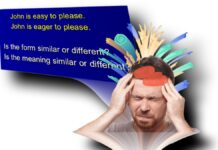Meaning is one of the central concerns of linguistics and semantics. Every word, phrase, or sentence conveys some kind of meaning, but meaning is not always straightforward or fixed. It depends on how language is structured, how it is used, and how it is interpreted by listeners or readers. Broadly speaking, meaning can be classified into several types based on the nature of expression and the context in which it occurs. Three important distinctions are lexical vs. grammatical meaning, denotative vs. connotative meaning, and situational vs. contextual meaning.
Lexical and Grammatical Meaning
Lexical Meaning
Lexical meaning refers to the dictionary meaning or content meaning of a word —what the word denotes independently of grammatical structure. It is the meaning carried by individual lexical items such as cat, run, happiness, or blue.
For instance, in the sentence “The cat slept on the mat,” the words cat, slept, and mat have distinct lexical meanings:
- cat = a small domesticated animal,
- slept = the action of resting in sleep,
- mat = a flat piece of material.
Lexical meaning is thus the core semantic content of a word, stored in our mental lexicon (vocabulary). It is what allows words to stand independently and convey meaning even outside a sentence.
Grammatical Meaning
Grammatical meaning arises from the function of words in a sentence and the relationships between them. It is expressed through inflections, word order, auxiliary verbs, prepositions, and other grammatical structures.
- He walks to school and They walk to school,
the change from walks to walk reflects grammatical meaning—specifically number and agreement (singular/plural).
- He walks to school and They walk to school,
Similarly, tense (walk / walked), aspect (is walking / has walked), and case (him / his) convey grammatical meaning. These meanings cannot be understood independently; they only make sense within the structure of a sentence.
- Lexical meaning = meaning of content words (nouns, verbs, adjectives, adverbs).
- Grammatical meaning = meaning derived from grammatical forms (tense, number, case, function words).
Both together create full sentence meaning—for example, “The children are playing outside” combines lexical meaning (children, play, outside) and grammatical meaning (present continuous tense, plural number, progressive aspect).
Denotative and Connotative Meaning
Denotative Meaning
Denotative meaning (also called literal or referential meaning) is the primary, objective meaning of a word —the kind you would find in a dictionary. It refers to the actual thing, idea, or action that the word represents, without emotional or cultural associations.
- Home denotes “a place where one lives.”
- Rose denotes “a type of flower.”
This meaning is fixed, universal, and context-independent. It focuses on what a word refers to rather than what it suggests.
Connotative Meaning
Connotative meaning refers to the emotional, cultural, or associative values that a word carries in addition to its denotation. These meanings are subjective and can vary between individuals, groups, or cultures.
- Home connotes warmth, safety, love, or family.
- Rose may connote beauty, romance, or fragility.
Similarly, the word snake denotes a reptile, but it often connotes deceit or danger in many cultures.
- Denotative meaning is objective, factual, and dictionary-based.
- Connotative meaning is subjective, emotional, and culturally influenced.
Example in contrast:
He is a fox.
- Denotative: He is an animal (literal).
- Connotative: He is clever or cunning (figurative, cultural).
Understanding both denotation and connotation is essential for interpreting poetry, advertisements, and persuasive writing, where emotional and symbolic meanings often outweigh literal ones.
Situational and Contextual Meaning
Situational Meaning
Situational meaning depends on the actual situation or circumstances in which language is used. It arises from real-world factors such as who is speaking, where, when, and to whom. Tone, gesture, and social setting also contribute to it.
If a teacher says “It’s cold in here” while looking at an open window, the situational meaning may be a polite request to close the window, even though the literal words are a statement about temperature.
Situational meaning therefore depends on non-linguistic cues and shared understanding between speaker and listener.
Contextual Meaning
Contextual meaning (or co-textual meaning) arises from the linguistic context—the words, phrases, and sentences that surround a particular expression. The meaning of a word or phrase can change according to the context in which it appears.
- “He broke the bank.” → In a casino context, it means he won all the money.
- “He broke the bank.” → In finance, it could mean he spent more money than he had.
The word light in different contexts:
- a light meal = small or not heavy;
- light colour = pale shade;
- light luggage = easy to carry.
Context tells us which sense is intended.
- Situational meaning depends on external (real-world) circumstances.
- Contextual meaning depends on the linguistic environment (words and sentences).
| Type of Meaning | Definition | Example |
| Lexical Meaning | Meaning of individual words independent of grammar. | book, run, red |
| Grammatical Meaning | Meaning conveyed by structure, form, or syntax. | walks / walked / walking |
| Denotative Meaning | Literal, dictionary meaning. | Rose = a flower |
| Connotative Meaning | Emotional or cultural associations. | Rose = love, beauty |
| Situational Meaning | Meaning derived from real-world circumstances of use. | “It’s cold here” (means “Close the window.”) |
| Contextual Meaning | Meaning determined by surrounding linguistic context. | “Light” (meal, colour, luggage, etc.) |
Meaning in language is not a single, fixed entity but a dynamic interaction between words, grammar, context, and situation.
- Lexical and grammatical meaning work together to form the structure of expression.
- Denotative and connotative meaning reflect both objective reference and subjective emotion.
- Situational and contextual meaning show how real-world circumstances and linguistic surroundings influence interpretation.
A complete understanding of meaning therefore requires examining how all these dimensions interact in actual communication.



























